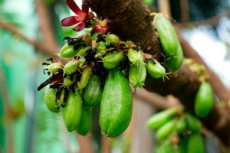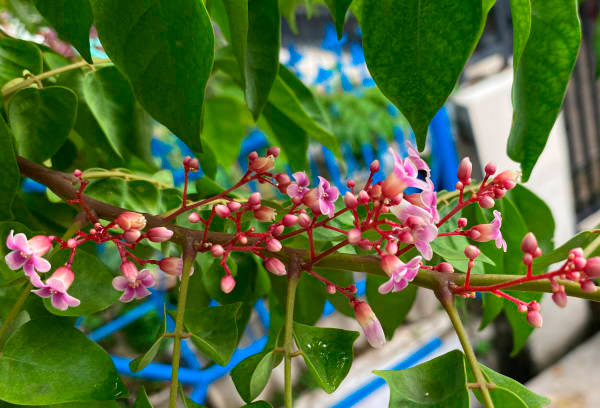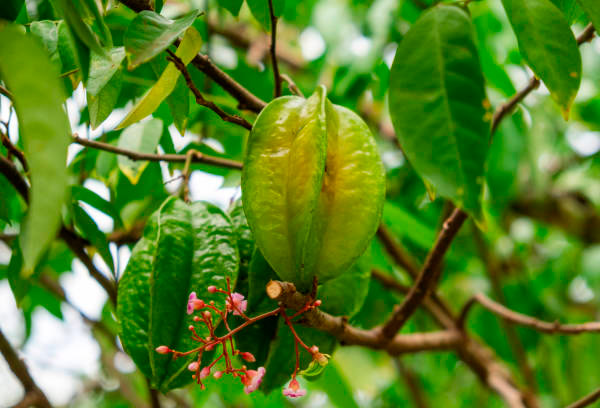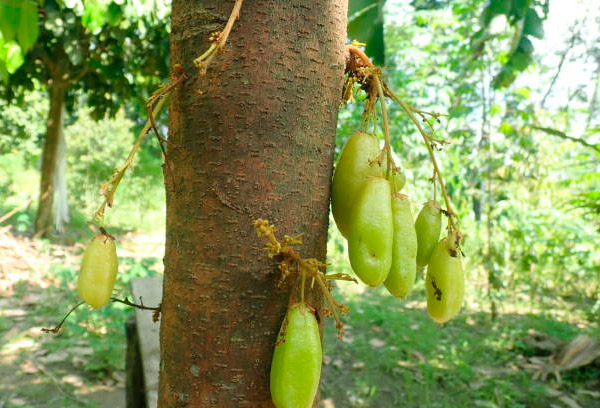New publications
Plants
Averrhoa
Last reviewed: 29.06.2025

Averrhoa (Latin: Averrhoa) is a genus of tropical trees and shrubs, widely known for their unusual fruits and attractive appearance. The most famous species are the starfruit ( Averrhoa carambola) and bilimbi ( Averrhoa bilimbi), whose fruits are used in cooking and traditional medicine. The plant is valued for its juicy, sweet-sour fruits, decorative flowers, and the ability to be grown in conditions close to subtropical environments.
Etymology of the name
The name "Averrhoa" comes from the Latinized form of the name of the philosopher and scholar Averroes (Ibn Rushd), a prominent Arab philosopher of the Middle Ages. It is likely that the botanists who discovered or first classified these plants named the genus in honor of the intellectual traditions of that time.
Life form
Averrhoa is typically found as an evergreen tree or tall shrub capable of reaching several meters in height. In its natural habitat, the plant forms a developed branching system and a dense crown, creating a characteristic microclimate with increased humidity.
In cultivation, especially when grown indoors or in greenhouses, Averrhoa may take a more compact form. The growth and habit largely depend on growing conditions: with optimal temperature and humidity, the shoots develop rapidly, forming a decorative and attractive plant.
Family
Averrhoa belongs to the Oxalidaceae family, which includes several genera of tropical and subtropical plants. Most members of the family have succulent fruits with a characteristic sour or sweet-sour taste due to the high content of organic acids.
Besides the Averrhoa genus, Oxalidaceae includes herbaceous plants from the Oxalis genus (sorrel), which are widespread in temperate and tropical regions. A unifying feature is the unique flower structure and the presence of oxalates in plant tissues.
Botanical characteristics
Averrhoa has simple or slightly pinnately-lobed leaves, arranged alternately. The flowers are usually small, gathered in panicles or clusters, five-petaled, with a prominent nectary. The fruits of Averrhoa are ribbed or polyhedral, juicy, with a characteristic tangy taste. The seeds are located in the center of the fruit, often in gelatinous pulp.

Averrhoa carambola
Chemical composition
The tissues of Averrhoa contain significant amounts of organic acids (oxalic, malic, citric), vitamins (especially vitamin C), flavonoids, and soluble sugars. This combination gives the fruit its sweet-sour taste and high nutritional value. Additionally, compounds in the leaves and bark may have anti-inflammatory and antioxidant properties.
Origin
The Averrhoa genus originates from the tropical regions of Southeast Asia, where it is most commonly found in countries such as Indonesia, Malaysia, and the Philippines. The warm and humid climate of these areas promotes rapid growth and abundant fruiting.
Gradually, Averrhoa spread to other subtropical and tropical regions, including South America, India, and parts of Africa. In several countries, the plant was acclimatized for its edible fruits and also as an ornamental plant.
Ease of growing
Averrhoa is considered a relatively demanding plant that requires a warm and humid climate. When grown indoors, it is necessary to provide abundant lighting, regular watering, and maintain increased air humidity.
Despite some challenges, Averrhoa can be cultivated in greenhouses, winter gardens, or enclosed balconies. With basic care, the plant grows steadily and may even form buds and fruits, although the scale of fruiting will be much less compared to its natural habitat.
Species and varieties
The most famous species include Averrhoa carambola, which produces star-shaped fruits, and Averrhoa bilimbi, which produces elongated sour fruits. There are also several cultivars with variations in acidity and fruit size, but overall, the genus is not known for having many cultivated varieties compared to other fruit plants.

Averrhoa carambola
Size
In its natural habitat, Averrhoa can reach 5–10 meters in height, forming a lush crown. The trunk remains relatively slender, and branching begins at a short distance from the ground, giving the plant a decorative appearance.
When grown indoors or in a greenhouse, the size is significantly limited by the volume of the pot and the frequency of pruning. Typically, the height does not exceed 1.5–2 meters, making Averrhoa suitable for indoor cultivation with sufficient space and high lighting.
Growth rate
Averrhoa demonstrates moderate or even rapid growth rates under warmth, light, and sufficient moisture. Shoots elongate especially actively in the spring-summer period, when the plant receives more sunlight and increased moisture.
At low temperatures or with insufficient nutrients, the growth rate significantly slows down. Young seedlings generally grow faster, but once the plant reaches a certain "mature" phase, the rate of vegetative mass increase somewhat decreases.
Lifespan
Under favorable conditions in a tropical climate, Averrhoa can maintain active growth and fruiting for 15–20 years or even longer. Regular renewal of shoots and the absence of extreme weather conditions help extend the plant's lifespan.
In indoor conditions, the lifespan may be shorter, especially when subjected to periodic stresses (lack of light, temperature fluctuations, soil drying). However, with proper care and correct agricultural techniques, the plant can survive indoors for 7–10 years or more.
Temperature
The optimal temperature range for Averrhoa is 20–28 °C. At these conditions, photosynthesis is active, buds form, and fruits are set. Short-term increases in temperature up to 30–32 °C are not critical but may require intensified watering and additional air humidity.
When the temperature drops below 15 °C, growth processes significantly slow down, and at 10 °C and lower, there is a risk of leaf damage. Temperatures below 5–7 °C can lead to plant death if protective measures are not taken.
Humidity
Averrhoa prefers moderate to high humidity (60–80%). In overly dry conditions, issues with bud drop, drying leaf tips, and overall reduction in decorativeness may occur. Regular spraying with warm water, using humidifiers, and frequent ventilation of the room help maintain the necessary humidity level.
Excessive moisture in the air, especially with poor circulation, can provoke fungal diseases. It is important to maintain balance: the plant loves moisture but cannot tolerate water stagnation on its leaves and stems.
Lighting and room placement
Averrhoa enjoys bright, diffused light. It is best to place it on east or west-facing windows where direct sunlight falls only during the morning or evening hours. During midday in hot regions, shading the plant is advisable to avoid leaf burns.
If natural lighting is insufficient, especially in winter, it is recommended to use phytolamps or daylight lamps. When placed in shaded corners, the plant will develop more slowly and may shed some of its leaves.
Soil and substrate
A light, fertile mix is suitable for Averrhoa, consisting of approximately 40% universal purchased soil, 20% peat, 20% coarse-grained sand or perlite, and 20% leaf mold or compost. This composition ensures good aeration and nourishment for the roots. The recommended acidity (pH) is in the range of 5.5–6.5. Drainage at the bottom of the pot is essential to prevent water stagnation: expanded clay, gravel, or vermiculite is commonly used.
Watering (summer and winter)
In summer, Averrhoa requires abundant and regular watering, ensuring the root ball does not dry out completely. However, the top layer of substrate should dry slightly to prevent root rot. On particularly hot days, daily soil moistening may be necessary.
In winter, watering intensity is reduced, considering the overall temperature drop and shorter daylight hours. Watering is done as the top layer of the substrate dries out to a depth of 2–3 cm. Overwatering in cold weather leads to soil acidification and the risk of fungal infections.
Fertilizing and feeding
Averrhoa requires regular feeding to maintain active growth and fruit formation. During spring and summer, apply complex mineral fertilizers with equal amounts of macroelements (NPK) every 2–3 weeks, additionally enriching the solutions with micronutrients.
During active flowering and fruit setting, the ratio of phosphorus and potassium can be increased to improve fruit quality. In autumn and winter, reduce the frequency of feeding to once every 4–6 weeks or stop entirely if the plant enters dormancy.
Flowering
Averrhoa flowers appear in small clusters, are white-pink or pink-lavender in color, and emit a mild pleasant fragrance. The flowering process can last several weeks, especially under stable temperature and abundant lighting conditions.
To stimulate flowering, it is important to maintain uniform growth conditions, avoid sharp temperature fluctuations, and provide the plant with enough nutrients. Lack of light or stress (overdrying, cooling) may cause buds to fall off.

Averrhoa bilimbi
Propagation
Averrhoa is primarily propagated by seeds or cuttings. Seeds are sown in spring in a loose mix, maintaining a temperature of 22–25 °C and high humidity. Germination occurs in 2–4 weeks, although there may be differences in fruiting characteristics compared to the parent plant.
Cuttings are propagated by taking semi-woody shoots 10–15 cm long and rooting them in a moist substrate or water. The best time for cutting is spring and early summer. At a temperature of around 25 °C and regular misting, roots appear within 3–4 weeks.
Seasonal features
In spring and summer, Averrhoa shows the most active growth, forming new leaves and flower buds. During this period, it is important to ensure intensified watering, high humidity, and regular feeding. Without direct scorching sunlight, the leaves retain their vibrant color, and flowers form abundantly.
In autumn and winter, growth slows down, and the plant may enter a dormant phase. When temperatures drop below 18 °C and daylight decreases, vegetative activity decreases, so watering and feeding frequency must be reduced.
Care features
The key to Averrhoa care is maintaining stable microclimate conditions and avoiding stress factors. Sharp temperature changes, irregular watering, and insufficient light can lead to leaf and bud drop.
The plant also responds positively to occasional spraying of leaves with warm water, which helps clean the leaves from dust and improve photosynthesis. It is important to regularly inspect Averrhoa for pests and diseases.
Home care
The first important point is the correct placement. Averrhoa feels best on southeast or southwest windows, where it receives enough light but does not suffer from midday sunlight. In case of insufficient lighting, phytolamps or daylight lamps are recommended.
The second aspect is maintaining a comfortable temperature and humidity. The room should maintain a temperature of 20–25 °C and humidity at 60–70%. If humidity is low, using a humidifier or placing the pot on a tray with moist gravel is beneficial.
The third point concerns watering and feeding. In summer, water abundantly but avoid waterlogging the plant. Feed every 2–3 weeks using complex mineral fertilizers. In winter, reduce watering, and feed less frequently or stop altogether if growth slows down.
Finally, to maintain the decorative appearance and prevent shoots from stretching, light pruning can be done, removing dried branches and pinching the tops, which helps form a denser crown.
Repotting
Choose a pot for Averrhoa based on the size of the root system. The new pot should be 2–3 cm larger in diameter than the previous one to avoid an overly large volume of substrate where moisture may stagnate. The pot material can be anything, but it must have drainage holes.
It is recommended to repot in spring when the active growth phase begins. Before repotting, dry the soil slightly to make it easier to extract the plant. After moving to the new container, water Averrhoa moderately and place it in partial shade for a few days for adaptation.
Pruning and crown shaping
Averrhoa tolerates formative pruning well, especially when young. Removing the tops of shoots and side branches stimulates the growth of additional branches, forming a dense, decorative crown.
It is best to prune the plant at the end of winter or early spring, before the active growth period begins. Cuts should be made with a sharp and sterile tool to minimize the risk of infections.
Possible problems and solutions
The most common diseases are fungal infections of the roots and leaves (fusarium, phytophthora) caused by overwatering and poor drainage. Correcting the watering regimen, applying fungicides, and improving soil aeration help solve the problem.
Nutrient deficiencies appear as chlorosis of the leaves, growth delay, and poor flowering. This can be addressed by applying balanced fertilizers with micronutrients. Care mistakes (overdrying or overwatering, lack of light) are corrected by changing the care regimen.
Pests
The main pests attacking Averrhoa are aphids, spider mites, and whiteflies. The warm and dry atmosphere of the room promotes their multiplication, so regular spraying and checking of leaves is recommended.
For prevention, biopesticides or household soap solutions can be used. In case of serious infestation, chemical treatments according to the instructions are used, and the affected plant should be isolated from healthy ones.
Air purification
Averrhoa, like many plants, contributes to improving indoor air quality. The leaves actively participate in photosynthesis, absorbing carbon dioxide and releasing oxygen, while also partially binding some volatile organic compounds.
Thanks to its large leaf mass, the plant can help increase air humidity, which is especially important in heated rooms with dry microclimates. However, Averrhoa should not be regarded as a full "filter"; its contribution is limited by the leaf area and the number of plants.
Safety
Averrhoa is not considered a particularly toxic plant, but the high content of organic acids in the fruit and leaf sap can cause irritation to mucous membranes upon direct contact. If the skin is highly sensitive, it is advisable to wear gloves when pruning or repotting.
Allergic reactions to Averrhoa are extremely rare, but some individuals may have an intolerance. If a rash or other symptoms occur, stop contact with the plant and consult a specialist if necessary.
Wintering
During winter, with the lack of natural light and relatively low temperatures, Averrhoa’s growth slows down. The optimal temperature for keeping the plant is 15–18 °C, which allows it to avoid severe stress and retain some of its leaves. Watering during this period is minimized.
With the arrival of spring, as the daylight length increases and temperatures rise, the plant gradually returns to its regular watering and feeding schedule. This "transition" phase helps Averrhoa switch to active growth smoothly.
Beneficial properties
Besides its decorative value, Averrhoa is known for its fruits, which are high in vitamin C and antioxidants. Eating fresh slices or drinking Averrhoa juice helps boost the immune system and improves digestion.
The refreshing effect is noted when Averrhoa fruits are added to drinks or salads. The sour taste is due to organic acids, which, in moderate amounts, are beneficial to health, but care should be taken in certain digestive conditions.
Use in traditional medicine or folk remedies
In some regions of Asia, Averrhoa juice and leaf tinctures are used to reduce fever, as a gargle for sore throat, and as a mild diuretic. However, the scientific basis for these methods is limited, and further verification is needed.
Sometimes, dried Averrhoa fruits are added to herbal teas, attributing them with properties that improve metabolism. In any case, it is recommended to consult a doctor or herbalist before using such remedies.
Use in landscape design
In warm climates, Averrhoa is planted as an ornamental tree in gardens, terraces, and greenhouses. Its spreading crown and interesting fruit shape attract attention and create an exotic accent.
In vertical gardens and hanging compositions, Averrhoa is used less frequently because it usually has a thick trunk and large leaves. However, with regular pruning, a more compact crown can be formed, suitable for ampelous designs.
Compatibility with other plants
Averrhoa coexists well with tropical and subtropical species that have similar temperature and humidity requirements. It can be placed in the same greenhouse or winter garden as citrus, hibiscus, coffee trees, etc.
However, it is important to consider the size of the crown: Averrhoa can overshadow its neighbors, so it is best placed at the back or center of a composition, leaving enough space for branch growth.
Conclusion
Averrhoa is an interesting plant from the Oxalidaceae family, combining decorative qualities and practical value due to its edible fruits. With careful attention to growing conditions (lighting, humidity, temperature), it can be grown in home greenhouses or conservatories even outside tropical regions.
Watching Averrhoa’s growth, flowering, and fruiting periods brings aesthetic pleasure and broadens the botanical horizons of gardeners. With proper care, the plant can become an interior decoration and a source of unusual sweet-sour fruits.
